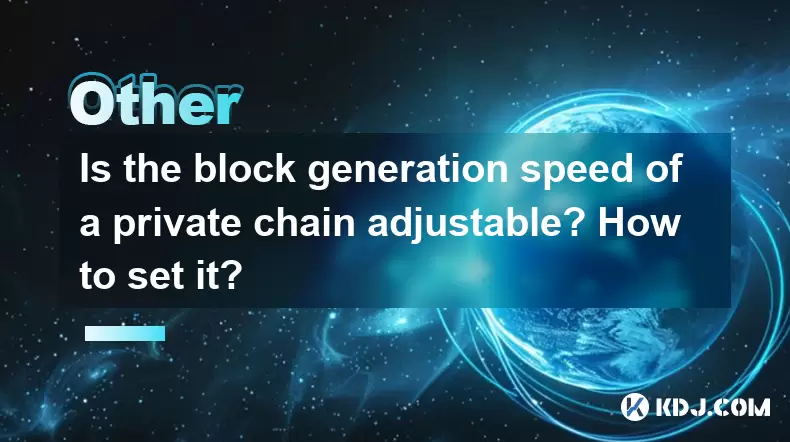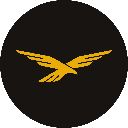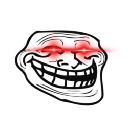-
 bitcoin
bitcoin $105968.894684 USD
4.17% -
 ethereum
ethereum $3639.320047 USD
7.62% -
 tether
tether $1.000339 USD
0.06% -
 xrp
xrp $2.407774 USD
5.96% -
 bnb
bnb $1011.704193 USD
2.28% -
 solana
solana $166.942754 USD
6.37% -
 usd-coin
usd-coin $1.000143 USD
0.03% -
 tron
tron $0.291515 USD
0.25% -
 dogecoin
dogecoin $0.181682 USD
4.06% -
 cardano
cardano $0.585450 USD
4.54% -
 hyperliquid
hyperliquid $42.099968 USD
5.20% -
 chainlink
chainlink $16.160745 USD
5.45% -
 zcash
zcash $645.269648 USD
12.96% -
 bitcoin-cash
bitcoin-cash $507.430338 USD
2.80% -
 stellar
stellar $0.290357 USD
3.69%
Is the block generation speed of a private chain adjustable? How to set it?
In private chains, block generation speed is adjustable, allowing customization to meet specific network needs, unlike fixed speeds in public blockchains like Bitcoin.
May 18, 2025 at 05:42 pm

Introduction to Private Chains and Block Generation Speed
Private chains, also known as permissioned blockchains, are networks where access and participation are restricted to a select group of users. One of the key features that can be customized in a private chain is the block generation speed, which refers to the rate at which new blocks are added to the blockchain. This article will explore whether the block generation speed of a private chain is adjustable and provide a detailed guide on how to set it.
Understanding Block Generation Speed
Block generation speed is a critical parameter in any blockchain network. It determines how quickly transactions are confirmed and added to the blockchain. In public blockchains like Bitcoin, the block generation speed is typically fixed and set to a specific interval, such as 10 minutes for Bitcoin. However, in private chains, this parameter can be adjusted to meet the specific needs of the network.
Adjustability of Block Generation Speed in Private Chains
The block generation speed in a private chain is indeed adjustable. Since private chains are designed to be more flexible and customizable, the administrators or developers of the network have the ability to modify various parameters, including the block generation speed. This flexibility allows private chains to be tailored to the specific requirements of the organization or consortium operating the network.
Factors Influencing Block Generation Speed
Several factors can influence the block generation speed in a private chain. These include:
- Network Consensus Mechanism: The consensus mechanism used by the private chain, such as Proof of Authority (PoA) or Practical Byzantine Fault Tolerance (PBFT), can affect the block generation speed. Different mechanisms have different performance characteristics.
- Hardware and Infrastructure: The hardware and infrastructure supporting the private chain can impact the speed at which blocks are generated. More powerful hardware can result in faster block generation.
- Network Size and Load: The size of the network and the volume of transactions being processed can also influence the block generation speed. A larger network with higher transaction volumes may require adjustments to maintain optimal performance.
How to Set the Block Generation Speed in a Private Chain
Setting the block generation speed in a private chain involves modifying the configuration files or parameters of the blockchain software. The exact steps can vary depending on the specific blockchain platform being used, such as Hyperledger Fabric, Ethereum Private Network, or Corda. Below is a general guide on how to set the block generation speed using Ethereum's Geth client as an example.
Install and Configure Geth: First, ensure that you have Geth installed and configured on your system. Geth is the command-line interface for running a full Ethereum node.
Create a Custom Genesis File: Create a custom genesis file that defines the initial state of your private chain. This file will include parameters such as the block generation speed.
Open a text editor and create a new file named
genesis.json.Add the following content to the file, adjusting the
blockTimeparameter to set the desired block generation speed:{ 'config': {'chainId': 15, 'homesteadBlock': 0, 'eip155Block': 0, 'eip158Block': 0}, 'difficulty': '0x400', 'gasLimit': '0x8000000', 'alloc': {}, 'blockTime': 5 // Set the block generation speed to 5 seconds}
Initialize the Private Chain: Use the Geth command to initialize the private chain with the custom genesis file.
Open a terminal and run the following command:
geth init --datadir ./chaindata genesis.json
Start the Node: Start the Geth node with the custom configuration.
Run the following command in the terminal:
geth --datadir ./chaindata --networkid 15 --mine --miner.threads 1 --miner.etherbase 0xYourAddressReplace
0xYourAddresswith the Ethereum address you want to use for mining.
Verify the Block Generation Speed: Once the node is running, you can verify the block generation speed by checking the blockchain's activity.
Use the Geth console to check the block time:
geth attach ./chaindata/geth.ipcIn the Geth console, run the following command to see the latest blocks and their timestamps:
eth.getBlock('latest').timestampCompare the timestamps of consecutive blocks to confirm the block generation speed.
Considerations When Adjusting Block Generation Speed
When adjusting the block generation speed in a private chain, it is important to consider the following:
- Security: Faster block generation speeds can potentially increase the risk of network attacks, such as 51% attacks. It is crucial to balance speed with security.
- Scalability: Adjusting the block generation speed can impact the scalability of the network. Faster speeds may lead to higher transaction throughput but could also increase the load on the network.
- Consistency: Ensure that all nodes in the private chain are configured with the same block generation speed to maintain network consistency and prevent forks.
Frequently Asked Questions
Q: Can the block generation speed be changed after the private chain is already running?A: Yes, the block generation speed can be changed after the private chain is running. However, this typically requires a network-wide update and consensus among all participants. The exact process can vary depending on the blockchain platform and the consensus mechanism in use.
Q: What are the potential risks of setting a very fast block generation speed?A: Setting a very fast block generation speed can increase the risk of network attacks, such as 51% attacks, where an attacker could potentially control the majority of the network's mining power. It can also lead to increased network load and potential scalability issues.
Q: How does the block generation speed affect transaction confirmation times?A: The block generation speed directly impacts transaction confirmation times. A faster block generation speed means that transactions are confirmed more quickly, as they are added to the blockchain in shorter intervals. Conversely, a slower block generation speed results in longer confirmation times.
Q: Are there any tools or software that can help monitor and adjust the block generation speed in real-time?A: Yes, there are several tools and software solutions available that can help monitor and adjust the block generation speed in real-time. For example, blockchain explorers and monitoring platforms like Etherscan or Blockscout can provide real-time data on block generation speeds. Additionally, some blockchain platforms offer built-in tools for adjusting network parameters dynamically.
Disclaimer:info@kdj.com
The information provided is not trading advice. kdj.com does not assume any responsibility for any investments made based on the information provided in this article. Cryptocurrencies are highly volatile and it is highly recommended that you invest with caution after thorough research!
If you believe that the content used on this website infringes your copyright, please contact us immediately (info@kdj.com) and we will delete it promptly.
- Zcash Price Prediction: Will the ZEC Breakout Continue?
- 2025-11-10 18:45:01
- XRP Price, AlphaPepe, and Predictions: What's the Buzz?
- 2025-11-10 18:55:01
- Crypto Explode: News Insights for Savvy Investors
- 2025-11-10 19:10:01
- XRP Price Rockets Amid ETF Buzz, Zcash Mimics Moonshot: A Breakdown
- 2025-11-10 19:10:01
- SaaS, Non-Human Identities, and User Authenticity: A New Era of Risk
- 2025-11-10 19:15:01
- BTC Treasury Bottom? Chanos Closes MSTR Short, Dogecoin Hints at Rebound
- 2025-11-10 19:40:02
Related knowledge

What are intents in crypto and how do they change user interaction?
Nov 09,2025 at 09:00am
Understanding the Role of Decentralized Exchanges in Modern Crypto Trading1. Decentralized exchanges, commonly known as DEXs, have reshaped how trader...

What is restaking and how does it enhance economic security?
Nov 09,2025 at 11:40pm
Understanding Restaking in the Blockchain Ecosystem1. Restaking refers to the process where users who have already staked their tokens in a proof-of-s...

What is a sovereign rollup and how does it differ from a smart contract rollup?
Nov 10,2025 at 09:00am
Understanding Sovereign Rollups1. A sovereign rollup operates as an independent blockchain layer that leverages the data availability of a base layer,...

What is a cryptographic nonce and how is it used to prevent replay attacks?
Nov 08,2025 at 05:00pm
Understanding Cryptographic Nonces in Blockchain Systems1. A cryptographic nonce is a number used only once within a specific cryptographic communicat...

What are the trade-offs between liveness and safety in a consensus protocol?
Nov 09,2025 at 12:20pm
Understanding the Role of Liquidity Pools in Decentralized Finance1. Liquidity pools are foundational components within decentralized exchanges (DEXs)...

What is a call data in an Ethereum transaction and how is it used?
Nov 09,2025 at 01:59am
Understanding Call Data in Ethereum Transactions1. Call data refers to the information sent along with a transaction on the Ethereum network that spec...

What are intents in crypto and how do they change user interaction?
Nov 09,2025 at 09:00am
Understanding the Role of Decentralized Exchanges in Modern Crypto Trading1. Decentralized exchanges, commonly known as DEXs, have reshaped how trader...

What is restaking and how does it enhance economic security?
Nov 09,2025 at 11:40pm
Understanding Restaking in the Blockchain Ecosystem1. Restaking refers to the process where users who have already staked their tokens in a proof-of-s...

What is a sovereign rollup and how does it differ from a smart contract rollup?
Nov 10,2025 at 09:00am
Understanding Sovereign Rollups1. A sovereign rollup operates as an independent blockchain layer that leverages the data availability of a base layer,...

What is a cryptographic nonce and how is it used to prevent replay attacks?
Nov 08,2025 at 05:00pm
Understanding Cryptographic Nonces in Blockchain Systems1. A cryptographic nonce is a number used only once within a specific cryptographic communicat...

What are the trade-offs between liveness and safety in a consensus protocol?
Nov 09,2025 at 12:20pm
Understanding the Role of Liquidity Pools in Decentralized Finance1. Liquidity pools are foundational components within decentralized exchanges (DEXs)...

What is a call data in an Ethereum transaction and how is it used?
Nov 09,2025 at 01:59am
Understanding Call Data in Ethereum Transactions1. Call data refers to the information sent along with a transaction on the Ethereum network that spec...
See all articles





















![The Graph Price Prediction [GRT Crypto Price News Today] The Graph Price Prediction [GRT Crypto Price News Today]](/uploads/2025/11/07/cryptocurrencies-news/videos/690d4df44fe69_image_500_375.webp)




















































